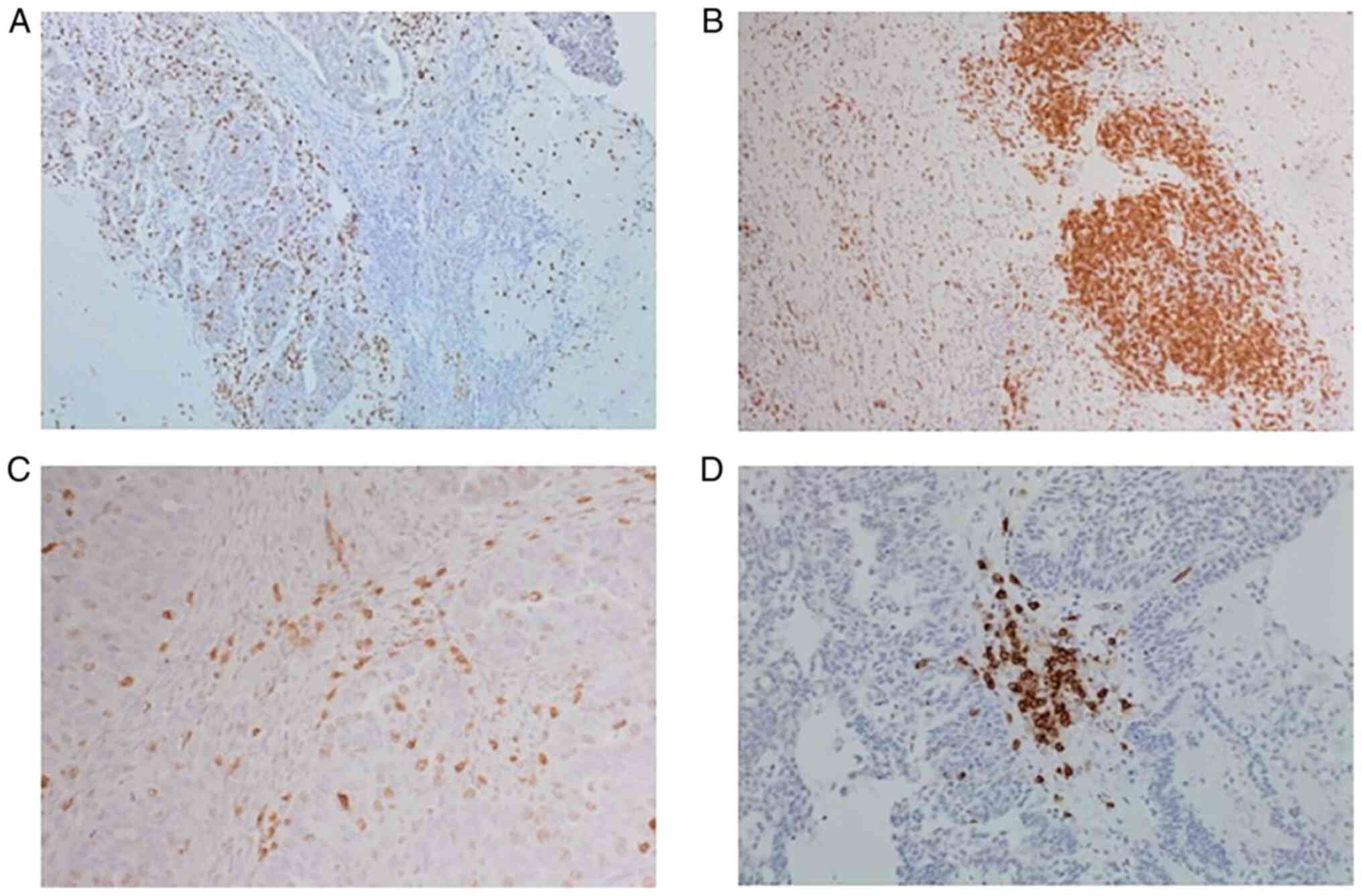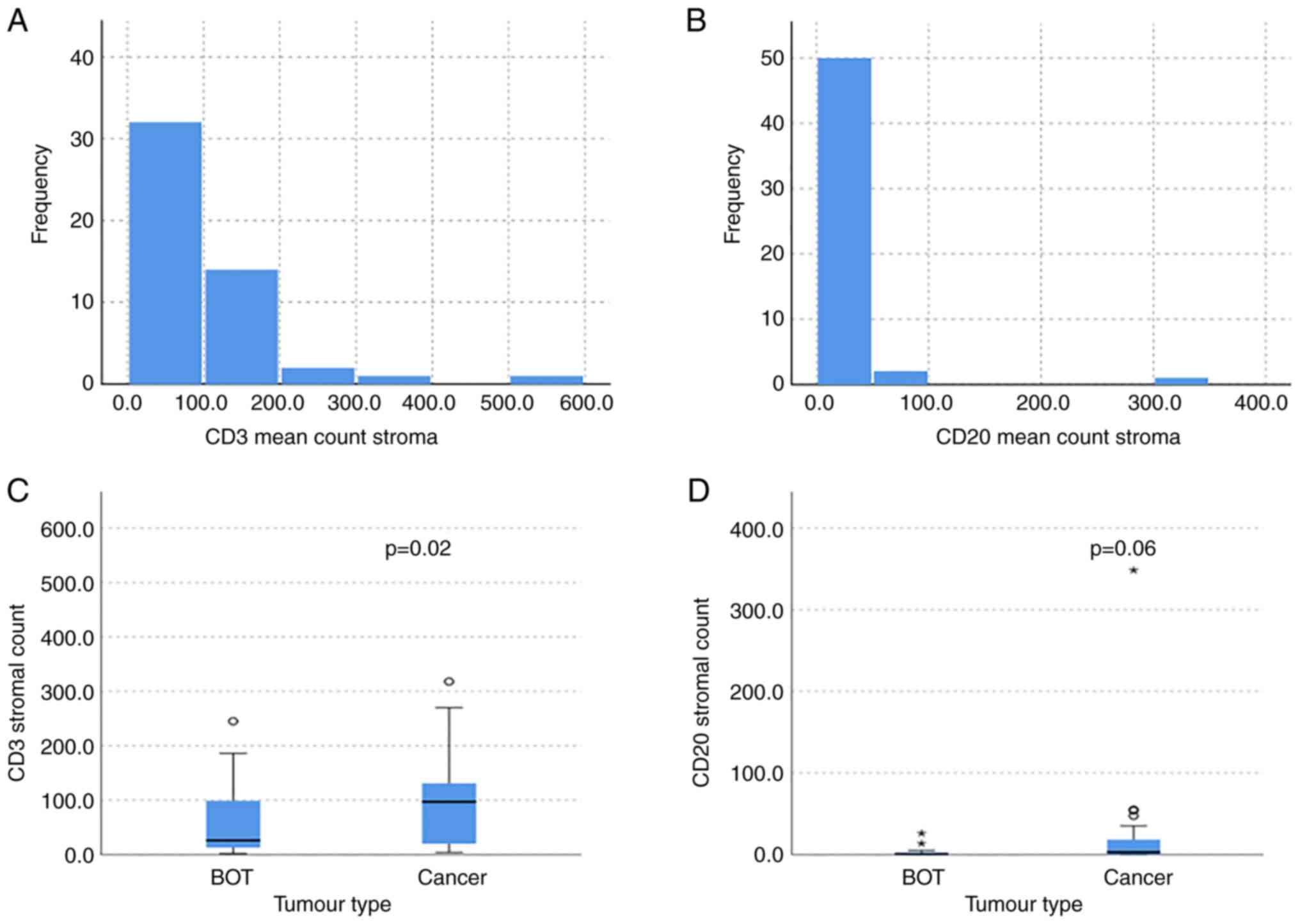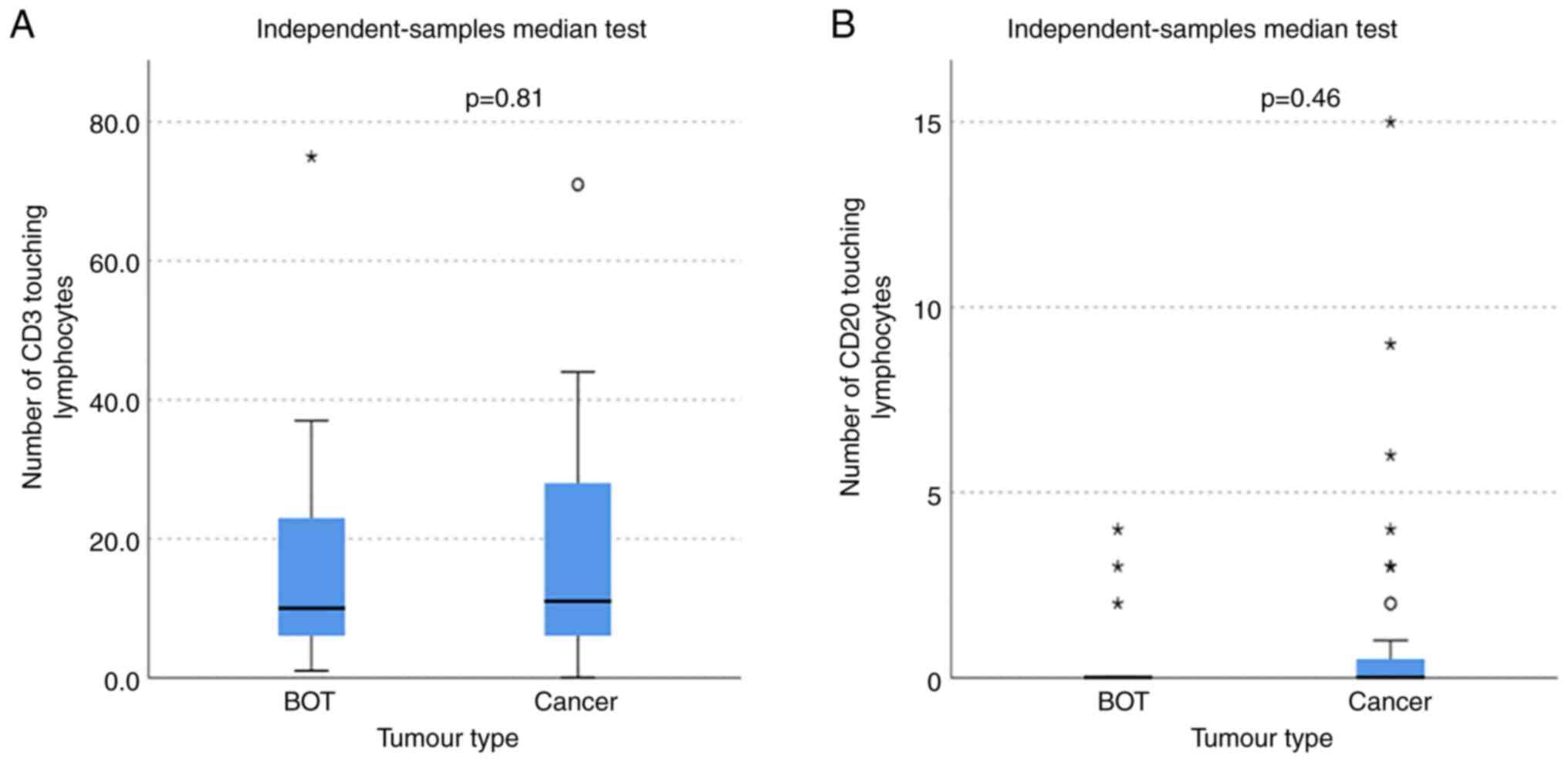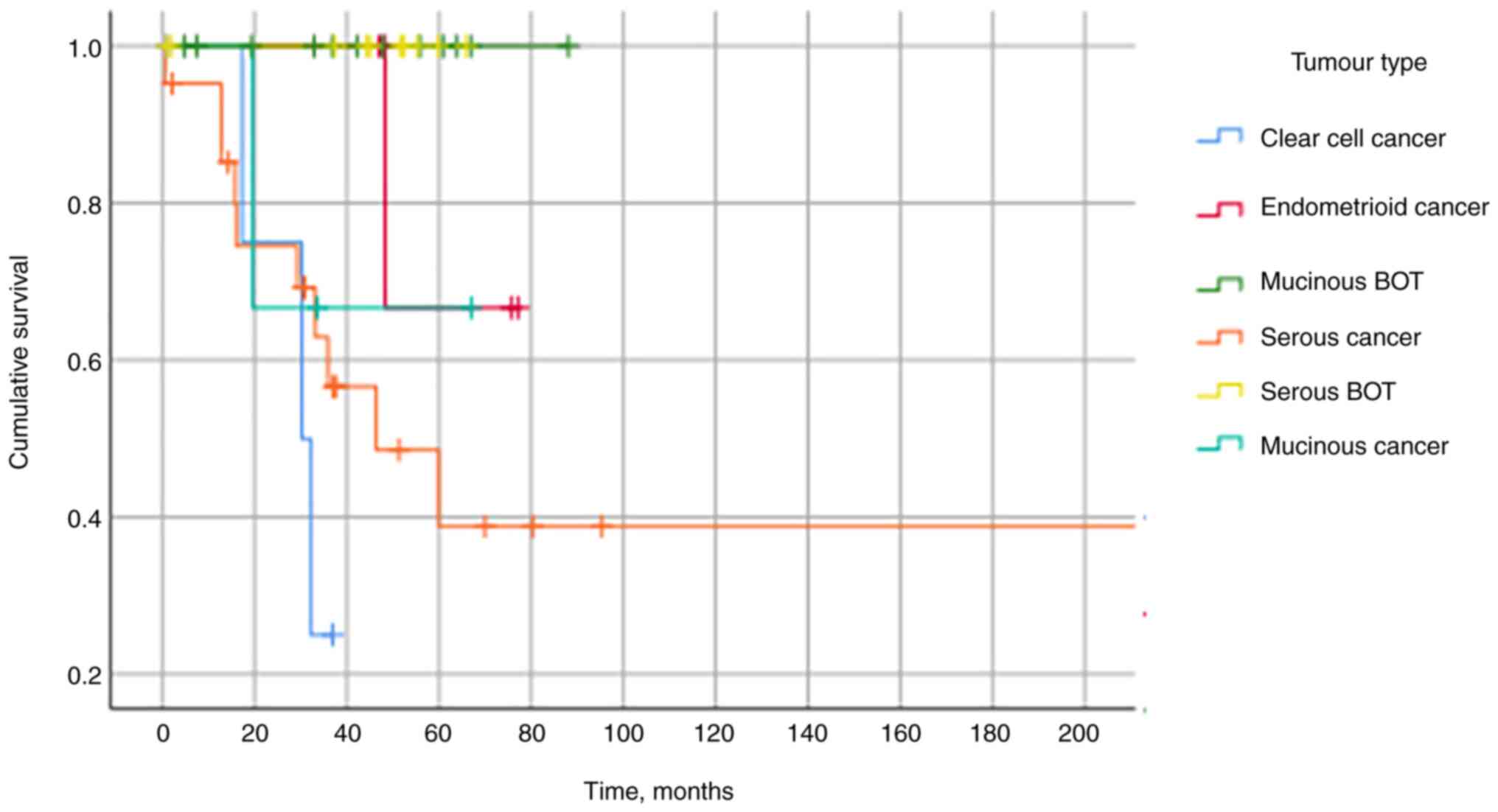|
1
|
Sung H, Ferlay J, Siegel RL, Laversanne M,
Soerjomataram I, Jemal A and Bray F: Global cancer statistics 2020:
GLOBOCAN estimates of incidence and mortality worldwide for 36
cancers in 185 countries. CA Cancer J Clin. 71:209–249. 2021.
View Article : Google Scholar : PubMed/NCBI
|
|
2
|
Cancer Research UK, . Available from.
https://www.cancerresearchuk.org/health-professional/cancer-statistics/statistics-by-cancer-type/vulval-cancer#heading-ZeroSeptember
14–2018
|
|
3
|
Lengyel E: Ovarian cancer development and
metastasis. Am J Pathol. 177:1053–1064. 2010. View Article : Google Scholar : PubMed/NCBI
|
|
4
|
Giornelli GH: Management of relapsed
ovarian cancer: A review. Springerplus. 5:11972016. View Article : Google Scholar : PubMed/NCBI
|
|
5
|
Ahmed N and Stenvers KL: Getting to know
ovarian cancer ascites: Opportunities for targeted therapy-based
translational research. Front Oncol. 3:2562013. View Article : Google Scholar : PubMed/NCBI
|
|
6
|
Kipps E, Tan DSP and Kaye SB: Meeting the
challenge of ascites in ovarian cancer: New avenues for therapy and
research. Nat Rev Cancer. 13:273–282. 2013. View Article : Google Scholar : PubMed/NCBI
|
|
7
|
Zhang L, Conejo-Garcia JR, Katsaros D,
Gimotty PA, Massobrio M, Regnani G, Makrigiannakis A, Gray H,
Schlienger K, Liebman MN, et al: Intratumoral T cells, recurrence,
and survival in epithelial ovarian cancer. N Engl J Med.
348:203–213. 2003. View Article : Google Scholar : PubMed/NCBI
|
|
8
|
Hendry S, Salgado R, Gevaert T, Russell
PA, John T, Thapa B, Christie M, van de Vijver K, Estrada MV,
Gonzalez-Ericsson PI, et al: Assessing tumor-infiltrating
lymphocytes in solid tumors: A practical review for pathologists
and proposal for a standardized method from the international
immunooncology biomarkers working group: Part 1: Assessing the host
immune response, TILs in invasive breast carcinoma and ductal
carcinoma in situ, metastatic tumor deposits and areas for further
research. Adv Anat Pathol. 24:235–251. 2017. View Article : Google Scholar : PubMed/NCBI
|
|
9
|
Garnelo M, Tan A, Her Z, Yeong J, Lim CJ,
Chen J, Lim KH, Weber A, Chow P, Chung A, et al: Interaction
between tumour-infiltrating B cells and T cells controls the
progression of hepatocellular carcinoma. Gut. 66:342–351. 2017.
View Article : Google Scholar : PubMed/NCBI
|
|
10
|
Sato E, Olson SH, Ahn J, Bundy B,
Nishikawa H, Qian F, Jungbluth AA, Frosina D, Gnjatic S, Ambrosone
C, et al: Intraepithelial CD8+ tumor-infiltrating lymphocytes and a
high CD8+/regulatory T cell ratio are associated with favorable
prognosis in ovarian cancer. Proc Natl Acad Sci USA.
102:18538–18543. 2005. View Article : Google Scholar : PubMed/NCBI
|
|
11
|
Toss MS, Miligy I, Al-Kawaz A, Alsleem M,
Khout H, Rida PC, Aneja R, Green AR, Ellis IO and Rakha EA:
Prognostic significance of tumor-infiltrating lymphocytes in ductal
carcinoma in situ of the breast. Mod Pathol. 31:1226–1236. 2018.
View Article : Google Scholar : PubMed/NCBI
|
|
12
|
Loi S, Sirtaine N, Piette F, Salgado R,
Viale G, Van Eenoo F, Rouas G, Francis P, Crown JPA, Hitre E, et
al: Prognostic and predictive value of tumor-infiltrating
lymphocytes in a phase III randomized adjuvant breast cancer trial
in node-positive breast cancer comparing the addition of docetaxel
to doxorubicin with doxorubicin-based chemotherapy: BIG 02–98. J
Clin Oncol. 31:860–867. 2013. View Article : Google Scholar : PubMed/NCBI
|
|
13
|
Hwang WT, Adams SF, Tahirovic E, Hagemann
IS and Coukos G: Prognostic significance of tumor-infiltrating T
cells in ovarian cancer: A meta-analysis. Gynecol Oncol.
124:192–198. 2012. View Article : Google Scholar : PubMed/NCBI
|
|
14
|
Burstein HJ, Curigliano G, Loibl S, Dubsky
P, Gnant M, Poortmans P, Colleoni M, Denkert C, Piccart-Gebhart M,
Regan M, et al: Estimating the benefits of therapy for early stage
breast cancer. The St gallen international consensus guidelines for
the primary therapy of early breast cancer 2019. Ann Oncol.
30:1541–1557. 2019. View Article : Google Scholar : PubMed/NCBI
|
|
15
|
Kos Z, Roblin E, Kim RS, Michiels S,
Gallas BD, Chen W, van de Vijver KK, Goel S, Adams S, Demaria S, et
al: Pitfalls in assessing stromal tumor infiltrating lymphocytes
(sTILs) in breast cancer. NPJ Breast Cancer. 6:172020. View Article : Google Scholar : PubMed/NCBI
|
|
16
|
de Lima CA, Jammal MP, Etchebehere RM,
Murta EFC and Nomelini RS: Lymphocytes in peritumoral stroma:
Evaluation in epithelial ovarian neoplasms. Immunol Invest.
49:397–405. 2020. View Article : Google Scholar : PubMed/NCBI
|
|
17
|
Hao J, Yu H, Zhang T, An R and Xue Y:
Prognostic impact of tumor-infiltrating lymphocytes in high grade
serous ovarian cancer: A systematic review and meta-analysis. Ther
Adv Med Oncol. 31:17588359209672412020.PubMed/NCBI
|
|
18
|
Darb-Esfahani S, Kolaschinski I, Trillsch
F, Mahner S, Concin N, Vergote I, Nieuwenhuysen EL, Achimas-Cadariu
P, Glajzer J, Woopen H, et al: Morphology and tumour-infiltrating
lymphocytes in high-stage, high-grade serous ovarian carcinoma
correlated with long-term survival. Histopathology. 73:1002–1012.
2018. View Article : Google Scholar : PubMed/NCBI
|
|
19
|
Nielsen JS, Sahota RA, Milne K, Kost SE,
Nesslinger NJ, Watson PH and Nelson BH: CD20+ tumor-infiltrating
lymphocytes have an atypical CD27-memory phenotype and together
with CD8+ T cells promote favorable prognosis in ovarian cancer.
Clin Cancer Res. 18:3281–3292. 2012. View Article : Google Scholar : PubMed/NCBI
|
|
20
|
Truxova I, Kasikova L, Hensler M, Skapa P,
Laco J, Pecen L, Belicova L, Praznovec I, Halaska MJ, Brtnicky T,
et al: Mature dendritic cells correlate with favorable immune
infiltrate and improved prognosis in ovarian carcinoma patients. J
Immunother Cancer. 4:1392018. View Article : Google Scholar : PubMed/NCBI
|
|
21
|
Lo CS, Sanii S, Kroeger DR, Milne K,
Talhouk A, Chiu DS, Rahimi K, Shaw PA, Clarke BA and Nelson BH:
Neoadjuvant chemotherapy of ovarian cancer results in three
patterns of tumor-infiltrating lymphocyte response with distinct
implications for immunotherapy. Clin Cancer Res. 23:925–934. 2017.
View Article : Google Scholar : PubMed/NCBI
|
|
22
|
Germain C, Gnjatic S, Tamzalit F,
Knockaert S, Remark R, Goc J, Lepelley A, Becht E, Katsahian S,
Bizouard G, et al: Presence of B cells in tertiary lymphoid
structures is associated with a protective immunity in patients
with lung cancer. Am J Respir Crit Care Med. 189:832–844. 2014.
View Article : Google Scholar : PubMed/NCBI
|
|
23
|
Ladányi A, Kiss J, Mohos A, Somlai B,
Liszkay G, Gilde K, Fejös Z, Gaudi I, Dobos J and Tímár J:
Prognostic impact of B-cell density in cutaneous melanoma. Cancer
Immunol Immunother. 60:1729–1738. 2011. View Article : Google Scholar : PubMed/NCBI
|
|
24
|
Iglesia MD, Vincent BG, Parker JS, Hoadley
KA, Carey LA, Perou CM and Serody JS: Prognostic B-cell signatures
using mRNA-seq in patients with subtype-specific breast and ovarian
cancer. Clin Cancer Res. 20:3818–3829. 2014. View Article : Google Scholar : PubMed/NCBI
|
|
25
|
Nedergaard BS, Ladekarl M, Nyengaard JR
and Nielsen K: A comparative study of the cellular immune response
in patients with stage IB cervical squamous cell carcinoma. Low
numbers of several immune cell subtypes are strongly associated
with relapse of disease within 5 years. Gynecol Oncol. 108:106–111.
2008. View Article : Google Scholar : PubMed/NCBI
|
|
26
|
Arias-Pulido H, Cimino-Mathews A, Chaher
N, Qualls C, Joste N, Colpaert C, Marotti JD, Foisey M, Prossnitz
ER, Emens LA and Fiering S: The combined presence of CD20 + B cells
and PD-L1 + tumor-infiltrating lymphocytes in inflammatory breast
cancer is prognostic of improved patient outcome. Breast Cancer Res
Treat. 171:273–282. 2018. View Article : Google Scholar : PubMed/NCBI
|
|
27
|
Milne K, Köbel M, Kalloger SE, Barnes RO,
Gao D, Gilks CB, Watson PH and Nelson BH: Systematic analysis of
immune infiltrates in high-grade serous ovarian cancer reveals
CD20, FoxP3 and TIA-1 as positive prognostic factors. PLoS One.
4:e64122009. View Article : Google Scholar : PubMed/NCBI
|
|
28
|
Montfort A, Pearce O, Maniati E, Vincent
BG, Bixby L, Böhm S, Dowe T, Wilkes EH, Chakravarty P, Thompson R,
et al: A strong B-cell response is part of the immune landscape in
human high-grade serous ovarian metastases. Clin Cancer Res.
23:250–262. 2017. View Article : Google Scholar : PubMed/NCBI
|
|
29
|
Maley CC, Aktipis A, Graham TA, Sottoriva
A, Boddy AM, Janiszewska M, Silva AS, Gerlinger M, Yuan Y, Pienta
KJ, et al: Classifying the evolutionary and ecological features of
neoplasms. Nat Rev Cancer. 17:605–619. 2017. View Article : Google Scholar : PubMed/NCBI
|
|
30
|
Valastyan S and Weinberg RA: Tumor
metastasis: Molecular insights and evolving paradigms. Cell.
147:275–292. 2011. View Article : Google Scholar : PubMed/NCBI
|
|
31
|
Hensler M, Kasikova L, Fiser K, Rakova J,
Skapa P, Laco J, Lanickova T, Pecen L, Truxova I, Vosahlikova S, et
al: M2-like macrophages dictate clinically relevant
immunosuppression in metastatic ovarian cancer. J Immunother
Cancer. 8:e0009792020. View Article : Google Scholar : PubMed/NCBI
|
|
32
|
Dai D, Liu L, Huang H, Chen S, Chen B, Cao
J, Luo X, Wang F, Luo R and Liu J: Nomograms to predict the density
of tumor-infiltrating lymphocytes in patients with high-grade
serous ovarian cancer. Front Oncol. 25:5904142021. View Article : Google Scholar : PubMed/NCBI
|
|
33
|
James FR, Jiminez-Linan M, Alsop J, Mack
M, Song H, Brenton JD, Pharoah PDP and Ali HR: Association between
tumour infiltrating lymphocytes, histotype and clinical outcome in
epithelial ovarian cancer. BMC Cancer. 20:6572017. View Article : Google Scholar : PubMed/NCBI
|
|
34
|
Geomini P, Kruitwagen R, Bremer GL,
Cnossen J and Mol BWJ: The accuracy of risk scores in predicting
ovarian malignancy: A systematic review. Obstet Gynecol. 113((2 Pt
1)): 384–394. 2009. View Article : Google Scholar : PubMed/NCBI
|
|
35
|
Zhang S, Yu S, Hou W, Li X, Ning C, Wu Y,
Zhang F, Jiao YF, Lee LTO and Sun L: Diagnostic extended usefulness
of RMI: Comparison of four risk of malignancy index in preoperative
differentiation of borderline ovarian tumors and benign ovarian
tumors. J Ovarian Res. 12:872019. View Article : Google Scholar : PubMed/NCBI
|
|
36
|
Robinson-Smith TM, Isaacsohn I, Mercer CA,
Zhou M, Van Rooijen N, Husseinzadeh N, McFarland-Mancini MM and
Drew AF: Macrophages mediate inflammation-enhanced metastasis of
ovarian tumors in mice. Cancer Res. 67:5708–5716. 2007. View Article : Google Scholar : PubMed/NCBI
|


















